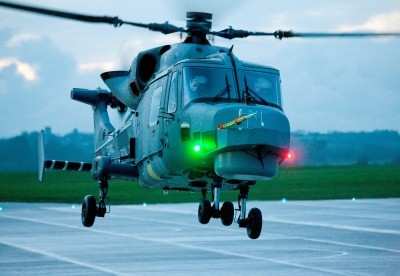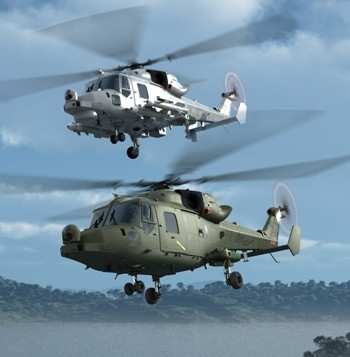Tue, Nov 23, 2010
Delivery Of Production Helicopters Expected In Late 2011
The third and final AW159 test aircraft successfully completed
its initial flight last Friday at AgustaWestland's Yeovil facility
in the UK. In a news release, AgustaWestland said the flight
involved a range of general handling checks, and the helicopter
performed as expected. The aircraft, designated TI3, is the third
of three test aircraft that will complete a 600 hour integrated
flight test program. This first flight comes just a few weeks after
the second AW159 (TI2) first flew. All the three aircraft flew
together for the first time Friday.

"This program will deliver unprecedented levels of capability
and cost/effectiveness to the services once the operational
readiness is achieved," said Graham Cole, Managing Director,
AgustaWestland.
Aircraft TI1 continues to perform air vehicle and flight
envelope testing while TI2 is undertaking the flight testing of the
aircraft's core and mission avionics systems, the systems and
software having already been developed and tested on
AgustaWestland's Full Systems Integration Rig (FSIR). TI3's main
task includes undertaking load survey trials and naval development,
including ship helicopter operating limit trials. AgustaWestland
has now also established a new AW159 production facility at its
Yeovil plant that introduces a pulse line production system to
bring significant efficiencies to the final assembly process. The
first production airframe was delivered to AgustaWestland by GKN
Aerospace in July 2010.

The first flight of the third AW159, known as the "Lynx Wildcat"
in UK military service, marks another step in the development of
this new six-ton multi-role military helicopter, 62 of which have
been ordered by the UK Ministry of Defence. The first aircraft will
be delivered at the end of 2011 with the aircraft becoming fully
operational with the Army in 2014 and the Royal Navy in 2015. The
British Army's AW159 Lynx Wildcat will perform a wide range of
tasks on the battlefield including reconnaissance, command and
control, transportation of troops and materiel, and the provision
of force protection. The Royal Navy variant will provide an agile
maritime capability providing anti-surface warfare capability and
force protection and will operate in support of amphibious
operations and be an important element in defending ships against
surface threats. There will be a high degree of commonality between
the Army and Royal Navy helicopters that will mean that an aircraft
can switch roles easily, principally through the changing of role
equipment.
More News
NORDO (No Radio) Aircraft that cannot or do not communicate by radio when radio communication is required are referred to as “NORDO.”>[...]
Aero Linx: South Carolina Aviation Association (SCAA) Airports in South Carolina support the state’s economy and are themselves economic generators. Residents, businesses, an>[...]
Also: AV-8B Harrier For CAF Arizona, Boeing Gets ODA, Army NG Rescue, Longitude To C. America A California Superior Court judge recently ruled that GAMI’s unleaded avgas does>[...]
Also: Williams International Builds Up, Marines v Drones, NBAA v Tariffs, New GAMA Members Hermeus confirmed the flight of its Quarterhorse MK 1 aircraft at the Air Force Test Cent>[...]
A Few Questions AND Answers To Help You Get MORE Out of ANN! 1) I forgot my password. How do I find it? 1) Easy... click here and give us your e-mail address--we'll send it to you >[...]
 ANN's Daily Aero-Term (06.04.25): NORDO (No Radio)
ANN's Daily Aero-Term (06.04.25): NORDO (No Radio) ANN's Daily Aero-Linx (06.04.25)
ANN's Daily Aero-Linx (06.04.25) Airborne 06.04.25: G100UL Legal Decision, FAA v Starship, Laser Conviction
Airborne 06.04.25: G100UL Legal Decision, FAA v Starship, Laser Conviction Airborne-NextGen 06.03.25: Hermeus Quarterhorse, VFS Forum, VX4 eVTOL
Airborne-NextGen 06.03.25: Hermeus Quarterhorse, VFS Forum, VX4 eVTOL ANN FAQ: Q&A 101
ANN FAQ: Q&A 101




